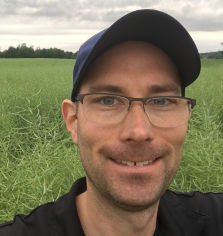

What is your job?
I lead a team of market development agronomists who help growers make agronomically sound decisions related to field crops. Prior to this role, I worked as an agronomist providing agronomic advice and checking fields on day-to-day basis. Agronomy staff are typically university educated and have, or are in the process of getting, their Certified Crop Advisor certification.
How does your work help farmers protect their crops from pests?
I coach my agronomy team on pest life cycle, staging, thresholds and management techniques. The staff in turn relay this information to growers through a variety of ways. It could be one-on-one communication, a field meeting, developing a recommendation with various control options, or checking the field to see if a specific threshold has been met. I also edit a newsletter that shares the same information in-season, of which some of the articles are written by my team. We also communicate with the agriculture community via Twitter and blogs on how to best approach a given pest. Our primary goal as agronomists is to first educate the grower on the fundamentals, and then determine if a decision is to be made.
How important is it for farmers to use a variety of tools and techniques to protect their crops?
It is critical to use a variety of tools from your tool box. For example; if a farmer has experienced Sclerotinia stem rot (white mold) in the past in their soybean crop, there are a number of practices that could reduce the risk of infection again in the future. The disease triangle has three sides (host, pathogen and environment), so we try and reduce one, if not two of these sides, to reduce the risk in future.
In soybeans, this may mean planting a variety that has a white mold tolerance rating, reducing the population and increasing row width both improve airflow, and then using a foliar fungicide to protect flowers if the weather conditions are conducive. By using multiple tools and techniques in this situation, the farmer has reduced their reliance on a single factor, one of the main yield robbers in soybean production. Whatever the solution, it always starts with understanding the basics of plant physiology and how it interacts with the environment.
Jonathan Zettler is a regional agronomy leader for Cargill in Ontario, Canada.